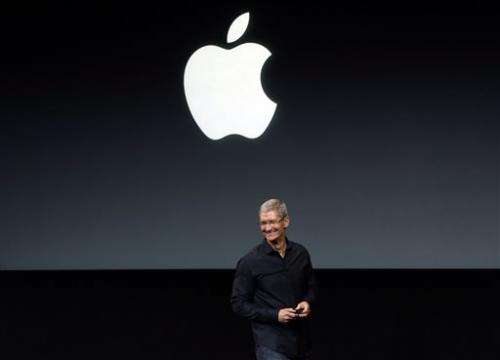In this Tuesday, Sept. 10, 2013, file photo, Apple CEO Tim Cook speaks on stage before a new product introduction in Cupertino, Calif. Apple is poised to reveal its next big thing Tuesday, Sept. 9, 2014, in a crucial attempt to prove its technological tastemakers still have the power to mesmerize the masses. (AP Photo/Marcio Jose Sanchez, File)
Along with larger iPhones, Apple is poised to unveil a wearable device—marking its first major entry in a new product category since the iPad's debut in 2010.
The move is significant because of recent questions about whether Apple still has a knack for innovating following the 2011 death of co-founder Steve Jobs.
Apple is turning to the past as it lays out its future. The company is holding the event at the Flint Center for the Performing Arts, the same venue where Jobs unveiled the industry-shifting Mac computer 25 years ago. The Cupertino, California, venue is near Apple's headquarters.
As for the iPhones, which still represent the main source of Apple's profits, larger models should help the company compete with Android devices.
Here's what's coming out of Tuesday's event:
___
A SMARTWATCH?
Apple's new wearable device has been dubbed the iWatch. It's likely to be a computerized watch or bracelet to help people monitor health, manage homes and even buy merchandise.
Consumer electronics companies have yet to demonstrate a compelling need for smartwatches, while bracelets have largely been niche products aimed at tracking fitness activities. Apple's device is expected to do more and do it well.
Consider the company's track record: Music players, smartphones and tablet computers existed long before Apple made its own versions. But they weren't mainstream or popular until the iPod, iPhone and iPad came along. Under Jobs, Apple made those products easy and fun to use.
Apple may use Tuesday's event merely to announce the wearable product, along with the price. There's speculation that the device wouldn't be available until early next year, though Apple was expected to start taking advance orders during the holiday shopping season.
___
LARGER iPHONES
As Samsung made its Android smartphones gradually larger over the years, Apple's iPhone had been stuck at 3.5 inches (9 centimeters), measured diagonally, until it got a slight boost to 4 inches (10 centimeters) in 2012.
Now, Apple is expected to increase that to at least 4.7 inches (12 centimeters). It might even release a 5.5-inch (14-centimeter) version. The gadgets won't be as big as Samsung's latest flagship phones—5.1 inches (13 centimeters) for the Galaxy S5 and 5.7 inches (14.5 centimeters) for the Note 4—but they will be large enough to neutralize a key advantage Samsung and other Android manufacturers have had.
Notably, Samsung's Note phone isn't getting bigger this year. Last year's Note 3 was 5.7 inches (14.5 centimeters). Instead, Samsung is emphasizing other hardware features, such as a sharper screen. It's also releasing a model with a curved edge to display weather, time and other information on the side of the phone.
___
NEW SOFTWARE
Though much of the attention has been on new gadgets, the software powering those gadgets is getting its annual refresh. Apple considers iOS 8 to be its biggest update since the introduction of the app store in 2008.
Existing iPhone and iPad users will be eligible for the free upgrade, too. Apple takes pride in pushing existing customers to the latest software, allowing app developers to incorporate new features without worrying about abandoning existing users. With Android, many recent phones can't be upgraded right away because of restrictions placed by manufacturers and wireless carriers.
Among other things, iOS 8 will let devices work better in sync. For instance, it'll be possible to start a message on an iPhone and finish it on an iPad. With an upcoming Mac upgrade called Yosemite, it'll be possible to continue working on that same message on a Mac computer as well.
The new iOS software will also let people do more things without jumping from app to app. For example, if a text message comes in as you're composing an email, you'll be able to pull down the text from the top edge and send a reply, all without leaving the email app.
A new keyboard aims to predict what you're about to type, going beyond standard spell-checking. You can install keyboards from outside parties, too, something Android already allows.
In fact, Apple is opening up more of its features to outside developers than in the past. The fingerprint sensor on iPhones won't be restricted to Apple's own services, for instance.
___
HOME AND HEALTH
Apple is rolling out the HomeKit and HealthKit systems. The idea is to turn Apple's products into a suite of digital servants that do everything from monitoring a person's eating habits and exercise routines to turning on the coffee maker in the morning.
Again, Apple isn't first in offering home and health monitoring systems. But consumers haven't rushed to buy those systems partly because products from various manufacturers don't always work with one another. With HomeKit and HealthKit, Apple is seeking to create some unity—with Apple's devices serving as a hub.
© 2014 The Associated Press. All rights reserved.
























